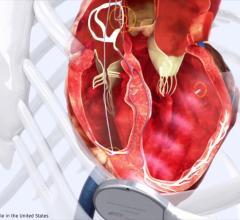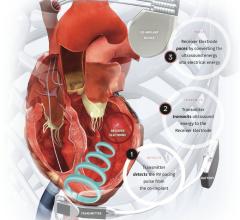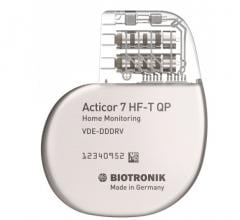June 6, 2013 — The American College of Cardiology and the American Heart Association released an expanded clinical practice guideline for the management of patients with heart failure, updating definitions and classifications for heart failure and increasing emphasis on patient-centric outcomes such as quality of life, shared decision making, care coordination, transitions and palliative care.
Approximately 5.1 million Americans have clinically manifested heart failure, which is a complex clinical syndrome that occurs when the heart’s ventricles cannot properly fill with or eject blood. More than 670,000 new cases are diagnosed annually and result in more than $30 billion of total healthcare costs.
Designed to assist clinicians in selecting the best management strategy for individual patients, the 2013 guideline provides expert analysis of data on prevention, diagnosis, risk stratification and treatment. Where data are lacking, evidence gaps are highlighted in the document.
Improving care quality, optimizing patient outcomes, and favorably affecting the efficient use of healthcare resources are all goals of the document, which was developed in collaboration with the American Academy of Family Physicians, American College of Chest Physicians, Heart Rhythm Society and the International Society for Heart and Lung Transplantation. The 2013 Heart Failure Guideline is a thorough reassessment of heart failure diagnosis and management that goes beyond the previous 2005 Heart Failure Guideline and corresponding 2009 focused update.
To draft the document, the ACC and AHA selected a multidisciplinary group of experts in cardiac care and asked them to perform a comprehensive literature review and to create a series of pertinent evidence tables. Writing committee members then weighed the strength of this evidence for or against certain tests or treatments and considered patient-specific modifiers that may influence care choices.
The guideline covers the full trajectory of both inpatient and outpatient care for patients with heart failure, from the initial evaluation through treatment stages A-D, including palliative care, and highlight quality improvement and optimal adherence to performance measures. Specific diagnostic strategies addressed included laboratory diagnostic tests, noninvasive cardiac imaging, invasive evaluation and detailed family histories with consideration for genetic screening, where applicable. The full range of treatment interventions including diuretics, ACE inhibitors, angiotensin-receptor blockers, beta blockers, statins, device therapy, mechanical circulatory support systems, cardiac transplantation and surgical/percutaneous/transcatheter interventions were considered.
According to writing committee chair Clyde W. Yancy, M.D., MSc, professor of medicine and chief of cardiology at Northwestern University Feinberg School of Medicine, highlights of the 2013 guideline include updated definitions and classifications for heart failure, a more focused approach to dilated cardiomyopathies, critical new indications for aldosterone antagonists and important new considerations for more discriminate use of cardiac resynchronization device therapy (CRT).
The document also discusses greater adherence to performance measures and quality measures (with timely recommendations to reduce readmissions) and places an even greater emphasis on patient-centric outcomes, such as quality-of-life issues, shared decision making, care coordination, transition of care, and palliative care.
The 2013 Heart Failure Guideline is among the first ACC/AHA guidance documents to utilize the new designation for optimal treatment. Termed “guideline-directed medical therapy” (GDMT), this new designation allows clinicians to easily determine the specific course of care deemed most important in the management of heart failure. Yancy noted that this important “call-out” of GDMT should be especially helpful for primary care physicians and physician extenders involved in the care of patients with heart failure.
“Amongst the many treatment recommendations in this guideline addressing care, the unambiguous nature of ‘GDMT’ emphasizes what works best and should be widely deployed,” he stated.
Writing committee vice chair Mariell Jessup, M.D., professor of medicine at the Perelman School of Medicine, University of Pennsylvania, adds that providing a more thorough analysis of heart failure with preserved ejection fraction (HFpEF) was a major focus of the 2013 guideline.
“From epidemiology through clinical presentation and therapeutics, medical and surgical, we have exercised every opportunity to make specific mention of issues related to HFpEF,” Jessup said. “In today’s clinical environment, at least half — if not more — of the patients we see today with heart failure have a preserved ejection fraction. It is critical to develop a frame through which we can all see these patients and further our research efforts into best therapies for this important iteration of heart failure.”
Yancy said the importance of the guideline cannot be underestimated. “Available data are clear that adherence to evidence-based guideline-directed care for heart failure improves outcomes,” he said. “The emphasis in this guideline on quality of care and performance improvement is well-placed and merits a firm embrace by those who see and treat patients with heart failure.”
The work of the writing committee was supported exclusively by the ACC and AHA without commercial support. Writing committee members volunteered their time and were required to disclose all healthcare-related relationships, including those existing one year before the initiation of the writing project.
Full text of the report, “2013 ACCF/AHA Guideline for the Management of Heart Failure,” will be published online and in the Aug. 27 print issue of the Journal of the American College of Cardiology. It will also be accessible on the ACC and AHA websites.
For more information: www.cardiosource.org, www.my.americanheart.org


 April 25, 2025
April 25, 2025 








